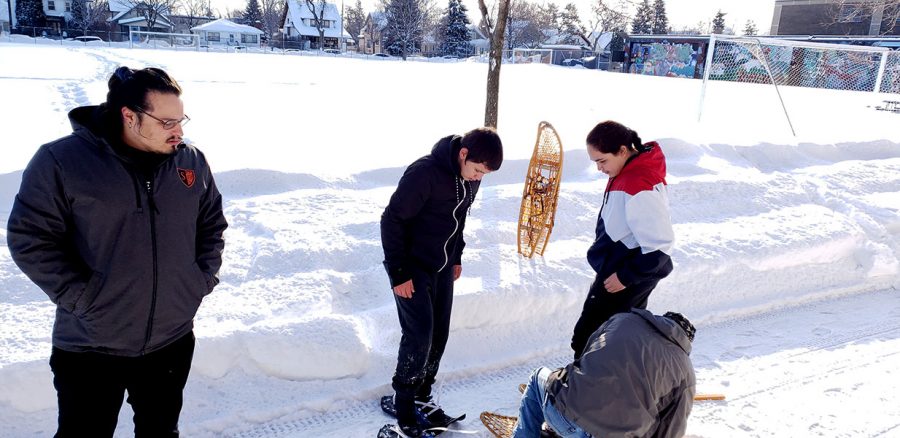Snowshoe creation teaches All Nations students cultural and scientific skills alike
Students put on previously made snowshoes near the field outside of South. In the coming weeks students in the All Nations program will be creating their own. “It’s a very culturally applicable project, really our students have kind of been into it, and I think that they can learn a lot from it,” said Vince Patton, the All Nations social studies teacher.
March 24, 2019
In the coming weeks, the All Nations Academic Seminar class of 9th graders will be making snowshoes. This is the first year of the project, which will be primarily led by All Nations Coordinator and Ojibwe teacher Bezh Butler. Students will be learning culturally applicable skills such as steam bending wood, adding webbing, and eventually using the snowshoes.
This project aligns with the values of the All Nations program. “We always try to provide learning opportunities…it’s kind of like an ultimate goal of our program. There’s science behind it, there’s Ojibwe language, and there’s traditional cultural knowledge that goes in with these snowshoes,” said Vince Patton, the All Nations social studies teacher. “It’s a very culturally applicable project, really our students have kind of been into it, and I think that they can learn a lot from it,” Patton continued.
Although not all students will be creating the wooden frames, everyone will have the opportunity to learn to do the webbing of the snowshoes. “I’m gonna teach some kids how to make them, but I’m gonna be teaching all the kids how to do the wrapping,” Butler said. “If they’re interested, anybody who wants to can make snowshoes, but you’re gonna kinda have to be dedicated to take a tree down to this level and then to do the webbing,” he continued.
The process of making snowshoes is long, and All Nations will be making two at a time. The first step of creating one is to chop down the tree into smaller pieces. Then it is braced in a certain way to allow steam bending of the wood, and left to dry for around 2 days. After the basic frame is created, other parts are added, such as the brace for your foot and the webbing, which most students will be doing.
For those who will not be creating the full snowshoe, Butler will be starting them with the basic wooden structure, and teach students how to add the webbing. “There’s just enough room to work on the inside of it, teach them how to weave it,” Butler described the snowshoes he will be making. He continued, “I’m getting [the wood] from my dad. He gathers it for us…He’s one of those type of guys who can go collect the stuff for us.” The main types of wood they will be using are ash and cedar.
Before All Nations begins making snowshoes, they are finishing some other projects. Recently, they have been tapping trees for maple syrup, which can be seen on nearby trees. “We tapped all the trees outside South, so we’re gonna start making [the snowshoes], I think this next week here,” Patton explained.
Additionally, students have been learning similar woodworking skills by making lacrosse sticks, which will help them for making snowshoes later on. “I’m still working on getting kids to be dedicated snowshoe makers, but first I’m gonna try to get kids to be dedicated lacrosse stick makers, and we’ll work on those skills, because this is a little bit harder to do, it’s a little bit more precise. Lacrosse sticks you can have your variations, but with snowshoes you have to be very precise,” Butler said.
Patton also drew similarities between the two. “There’s huge parallels. From carving…to using the certain tools that we got, as a draw horse, or like a draw blade, using those things…we are gonna steam bend wood that we have in our lacrosse sticks, in the same fashion, technique, as in our snowshoes,” he said
Mato Thompson, one of the students who will be working on a full snowshoe, described his experience making a lacrosse stick. “We had to carve down the wood to make the handle, and then we had to heat up some plastic to make the net,” Thompson said. Although he has never made snowshoes before, he said, “I’m excited to use them.”
All of these projects were funded by grants that All Nations teachers applied for. Carmen Vanegas, a science teacher for the program, helped with the application. “Our science teacher Ms. Vanegas is really good at finding money, and she just came through one day and said, ‘Hey, there’s this grant where they’re giving out $10,000 to support teachers, we should go for it’…she just starts typing away and asking me questions, and I’m just like, ‘Okay. Alright, let’s do this.’ So our first grant was for $10,000 from the University of Minnesota,” Butler described.
“She helped us get this grant, a bunch of money, so we have the ability to build canoes, build lacrosse sticks, do certain things, like make snowshoes,” Patton elaborated.
With these projects, the All Nations team hopes to use cultural applications to teach typical school subjects and skills while also providing cultural experiences for students. “The largest part of our program is providing as many cultural and experimental learning activities as possible. Our students do so much better when they’re able to hands-on apply some knowledge they learned, some cultural experience. They are way more engaged in activities like that than a worksheet talking about parallelograms,” Patton explained. He also noted examples such as learning chemistry from steam bending wood.
With the snow melting and a lot of work ahead of them, students likely won’t be using snowshoes this winter, but be sure to look for them next year out on top of the snow.






